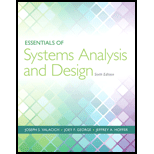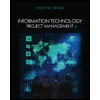
Pearson eText for Essentials of Systems Analysis and Design -- Instant Access (Pearson+)
6th Edition
ISBN: 9780137612420
Author: Joseph Valacich, Joey George
Publisher: PEARSON+
expand_more
expand_more
format_list_bulleted
Expert Solution & Answer
Chapter 4, Problem 8M
Program Description Answer
Intangible benefit is defined as the benefit that is derived by creating an
Hence, correct answer is “Intangible benefit”.
Expert Solution & Answer
Want to see the full answer?
Check out a sample textbook solution
Students have asked these similar questions
7. Long-Distance CallsA long-distance provider charges the following rates for telephone calls:
Rate Category Rate per MinuteDaytime (6:00 a.m. through 5:59 p.m.) $0.07Evening (6:00 p.m. through 11:59 p.m.) $0.12Off-Peak (midnight through 5:59 a.m.) $0.05Write a GUI application that allows the user to select a rate category (from a set of radio buttons), and enter the number of minutes of the call into an Entry widget. An info dialog box should display the charge for the call.
Name and Address
The Name and Address Problem
Write a GUI program that displays your name and address when a button is clicked. The program’s window should appear as the sketch on the left side of Figure 13-61 when it runs. When the user clicks the Show Info button, the program should display your name and address, as shown in the sketch on the right of the figure.
Exercise 1 Function and Structure [30 pts]
Please debug the following program and answer the following questions. There is a cycle in a linked
list if some node in the list can be reached again by continuously following the next pointer.
#include
typedef struct node {
int value;
struct node *next;
} node;
int 11_has_cycle (node *first)
if (first
==
node *head =
{
NULL) return 0;
first;
while (head->next != NULL) {
}
if (head
first) {
return 1; }
head = head->next;
return 0;
void test ll_has_cycle () {
int i;
node nodes [6];
for (i = 0; i < 6; i++) {
nodes [i] .next = NULL;
nodes [i].value = i;
}
nodes [0] .next
=
&nodes [1];
nodes [1] .next
=
&nodes [2];
nodes [2] .next
=
&nodes [3];
nodes [3] .next
nodes [4] .next
&nodes [4];
NULL;
nodes [5] .next = &nodes [0];
printf("1. Checking first list for cycles. \n Function 11_has_cycle says it
has s cycle\n\n", 11_has_cycle (&nodes [0])?"a":"no");
printf("2. Checking length-zero list for cycles. \n Function 11_has_cycle
says it has %s…
Chapter 4 Solutions
Pearson eText for Essentials of Systems Analysis and Design -- Instant Access (Pearson+)
Ch. 4 - Prob. 1MCh. 4 - Prob. 2MCh. 4 - Prob. 3MCh. 4 - Prob. 4MCh. 4 - Prob. 5MCh. 4 - Prob. 6MCh. 4 - Prob. 7MCh. 4 - Prob. 8MCh. 4 - Prob. 9MCh. 4 - Prob. 10M
Ch. 4 - Prob. 11MCh. 4 - Prob. 12MCh. 4 - Prob. 13MCh. 4 - Prob. 14MCh. 4 - Prob. 15MCh. 4 - Prob. 16MCh. 4 - Prob. 17MCh. 4 - Prob. 18MCh. 4 - Prob. 19MCh. 4 - Prob. 20MCh. 4 - Prob. 21MCh. 4 - Prob. 22MCh. 4 - Prob. 1RQCh. 4 - Describe several project evaluation criteria.Ch. 4 - Prob. 3RQCh. 4 - Prob. 4RQCh. 4 - Prob. 5RQCh. 4 - Prob. 6RQCh. 4 - What are the potential consequences of not...Ch. 4 - Prob. 8RQCh. 4 - Prob. 9RQCh. 4 - Prob. 10RQCh. 4 - Prob. 11RQCh. 4 - Prob. 12PECh. 4 - Prob. 13PECh. 4 - Prob. 14PECh. 4 - Prob. 15PECh. 4 - Prob. 16PECh. 4 - Prob. 17PECh. 4 - Prob. 18PECh. 4 - Prob. 19PECh. 4 - Prob. 20PECh. 4 - Prob. 21PECh. 4 - Assume monetary benefits of an information system...Ch. 4 - Prob. 23PECh. 4 - Prob. 24PECh. 4 - Prob. 25PECh. 4 - Prob. 26PECh. 4 - Prob. 27PECh. 4 - Prob. 28PECh. 4 - Prob. 29DQCh. 4 - Prob. 30DQCh. 4 - Prob. 31DQCh. 4 - Prob. 32DQCh. 4 - Prob. 33CPCh. 4 - Prob. 34CPCh. 4 - Prob. 35CPCh. 4 - Prob. 36CQCh. 4 - Prob. 37CQCh. 4 - Identify a preliminary set of tangible and...Ch. 4 - Prob. 39CQCh. 4 - If you were assigned to help Jim with this...Ch. 4 - Prob. 41CQCh. 4 - Prob. 42CQCh. 4 - In Question 4, you analyzed the risks associated...
Knowledge Booster
Similar questions
- how to read log logsarrow_forwardDiscrete Mathematics for Computer Engineeringarrow_forwardQuestion 1 - Array Iterators Like the JS on A2, there is no visual component to this question. The HTML really just needs to load the JavaScript, everything else will output to the console. The JS file should the completion of the task, and all necessary testing, so that just loading the file will complete the task with enough different inputs to ensure it works. Even Numbers [3 marks] Create a function that determines if a provided number is even. Define an array of numbers, then on the array use the appropriate array iterator to determine if the array contains only even numbers using the function you defined. Output the results, and test with several arrays. Long Names [3 marks] Define an array of names. Use an iterator to retrieve a new array containing only the names longer then 12 characters. Your iterator should be passed an anonymous arrow function. Test with several different arrays First Names [3 marks] Define an array called fullNames that contains 7 javascript objects of…arrow_forward
- Discrete Mathematics for Computer Engineeringarrow_forwardthis module is java 731 . make sure my answers are 1005 correct and the layout and structure is perfect and also include all comments etc. thank you i have attached question 1 (40 marks) and question 2 (30 marks ) this is question 3: Question3: (30 MARKS) Passenger Rail Agency for South Africa Train Scheduling System Problem Statement Design and implement a train scheduling system for Prasa railway network. The system should handle the following functionalities: 1. Scheduling trains: Allow the addition of train schedules, ensuring that no two trains use the same platform at the same time at any station. 2. Dynamic updates: Enable adding new train schedules and canceling existing ones. 3. Real-time simulation: Use multithreading to simulate the operation of trains (e.g., arriving, departing). 4. Data management: Use ArrayList to manage train schedules and…arrow_forwardthis module is java 731 . make sure my answers are 1005 correct and the layout and structure is perfect and also include all comments etc. thank you i have attached question 1 (40 marks) and question 2 (30 marks ) this is question 3: Question3: (30 MARKS) Passenger Rail Agency for South Africa Train Scheduling System Problem Statement Design and implement a train scheduling system for Prasa railway network. The system should handle the following functionalities: 1. Scheduling trains: Allow the addition of train schedules, ensuring that no two trains use the same platform at the same time at any station. 2. Dynamic updates: Enable adding new train schedules and canceling existing ones. 3. Real-time simulation: Use multithreading to simulate the operation of trains (e.g., arriving, departing). 4. Data management: Use ArrayList to manage train schedules and…arrow_forward
- this module is java 731 . make sure my answers are 1005 correct and the layout and structure is perfect and also include all comments etc. thank you i have attached question 1 (40 marks) and question 2 (30 marks ) this is question 3: Question3: (30 MARKS) Passenger Rail Agency for South Africa Train Scheduling System Problem Statement Design and implement a train scheduling system for Prasa railway network. The system should handle the following functionalities: 1. Scheduling trains: Allow the addition of train schedules, ensuring that no two trains use the same platform at the same time at any station. 2. Dynamic updates: Enable adding new train schedules and canceling existing ones. 3. Real-time simulation: Use multithreading to simulate the operation of trains (e.g., arriving, departing). 4. Data management: Use ArrayList to manage train schedules and…arrow_forwardDiscrete Mathematics for Computer Engineeringarrow_forwardTask 1: Write an abstract class Method +: public -: private #: protected Underline: static # input: int # output:String Method + isHard():boolean + specificWay():String + Method() + Method(input: int, output: String) + getInput(): int + setInput(input: int): void + getOutput(): String + setOutput(output: String): void +toString(): String Question Task 2: Write a class ReadMethod that extends the Method class. +: public -: private #: protected Underline: static -language: String ReadMethod Question + ReadMethod() + ReadMethod(input: int, output: String, language: String) + isHard():boolean + specific Way(): String +toString(): String + getLanguage(): String + setLanguage(language: String): voidarrow_forward
- i have attatched my java question , please make sure it is answered correct, include all comments etc, thank youarrow_forwardi have attached my 2 java questions . please answer them correctly, add all comments etc . thank you.arrow_forwardCan you help me solve this problem using Master's Theorem:Solve the recurrence relation f(n) = 3af(n/a) + (n + a)2 with f(1) = 1 and a > 1 byfinding an expression for f(n) in big-Oh notation.arrow_forward
arrow_back_ios
SEE MORE QUESTIONS
arrow_forward_ios
Recommended textbooks for you
 Information Technology Project ManagementComputer ScienceISBN:9781337101356Author:Kathy SchwalbePublisher:Cengage Learning
Information Technology Project ManagementComputer ScienceISBN:9781337101356Author:Kathy SchwalbePublisher:Cengage Learning Information Technology Project ManagementComputer ScienceISBN:9781285452340Author:Kathy SchwalbePublisher:Cengage Learning
Information Technology Project ManagementComputer ScienceISBN:9781285452340Author:Kathy SchwalbePublisher:Cengage Learning Database Systems: Design, Implementation, & Manag...Computer ScienceISBN:9781305627482Author:Carlos Coronel, Steven MorrisPublisher:Cengage Learning
Database Systems: Design, Implementation, & Manag...Computer ScienceISBN:9781305627482Author:Carlos Coronel, Steven MorrisPublisher:Cengage Learning Database Systems: Design, Implementation, & Manag...Computer ScienceISBN:9781285196145Author:Steven, Steven Morris, Carlos Coronel, Carlos, Coronel, Carlos; Morris, Carlos Coronel and Steven Morris, Carlos Coronel; Steven Morris, Steven Morris; Carlos CoronelPublisher:Cengage Learning
Database Systems: Design, Implementation, & Manag...Computer ScienceISBN:9781285196145Author:Steven, Steven Morris, Carlos Coronel, Carlos, Coronel, Carlos; Morris, Carlos Coronel and Steven Morris, Carlos Coronel; Steven Morris, Steven Morris; Carlos CoronelPublisher:Cengage Learning Fundamentals of Information SystemsComputer ScienceISBN:9781305082168Author:Ralph Stair, George ReynoldsPublisher:Cengage Learning
Fundamentals of Information SystemsComputer ScienceISBN:9781305082168Author:Ralph Stair, George ReynoldsPublisher:Cengage Learning Management Of Information SecurityComputer ScienceISBN:9781337405713Author:WHITMAN, Michael.Publisher:Cengage Learning,
Management Of Information SecurityComputer ScienceISBN:9781337405713Author:WHITMAN, Michael.Publisher:Cengage Learning,

Information Technology Project Management
Computer Science
ISBN:9781337101356
Author:Kathy Schwalbe
Publisher:Cengage Learning

Information Technology Project Management
Computer Science
ISBN:9781285452340
Author:Kathy Schwalbe
Publisher:Cengage Learning

Database Systems: Design, Implementation, & Manag...
Computer Science
ISBN:9781305627482
Author:Carlos Coronel, Steven Morris
Publisher:Cengage Learning

Database Systems: Design, Implementation, & Manag...
Computer Science
ISBN:9781285196145
Author:Steven, Steven Morris, Carlos Coronel, Carlos, Coronel, Carlos; Morris, Carlos Coronel and Steven Morris, Carlos Coronel; Steven Morris, Steven Morris; Carlos Coronel
Publisher:Cengage Learning

Fundamentals of Information Systems
Computer Science
ISBN:9781305082168
Author:Ralph Stair, George Reynolds
Publisher:Cengage Learning

Management Of Information Security
Computer Science
ISBN:9781337405713
Author:WHITMAN, Michael.
Publisher:Cengage Learning,